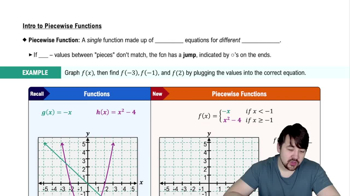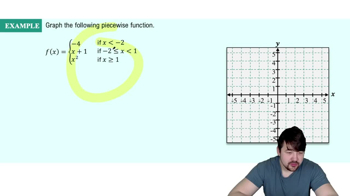Table of contents
- 0. Functions7h 52m
- Introduction to Functions16m
- Piecewise Functions10m
- Properties of Functions9m
- Common Functions1h 8m
- Transformations5m
- Combining Functions27m
- Exponent rules32m
- Exponential Functions28m
- Logarithmic Functions24m
- Properties of Logarithms34m
- Exponential & Logarithmic Equations35m
- Introduction to Trigonometric Functions38m
- Graphs of Trigonometric Functions44m
- Trigonometric Identities47m
- Inverse Trigonometric Functions48m
- 1. Limits and Continuity2h 2m
- 2. Intro to Derivatives1h 33m
- 3. Techniques of Differentiation3h 18m
- 4. Applications of Derivatives2h 38m
- 5. Graphical Applications of Derivatives6h 2m
- 6. Derivatives of Inverse, Exponential, & Logarithmic Functions2h 37m
- 7. Antiderivatives & Indefinite Integrals1h 26m
- 8. Definite Integrals4h 44m
- 9. Graphical Applications of Integrals2h 27m
- 10. Physics Applications of Integrals 2h 22m
0. Functions
Piecewise Functions
Problem 104
Textbook Question
{Use of Tech} Triple intersection Graph the functions f(x) = x³,g(x)=3^x, and h(x)=x^x and find their common intersection point (exactly).
 Verified step by step guidance
Verified step by step guidance1
Step 1: Understand the problem by identifying the functions involved: f(x) = x^3, g(x) = 3^x, and h(x) = x^x. We need to find the common intersection point of these three functions.
Step 2: Set up the equations for intersection by equating the functions pairwise: f(x) = g(x), g(x) = h(x), and f(x) = h(x). This will help us find the x-values where the functions intersect.
Step 3: Solve the equation f(x) = g(x), which is x^3 = 3^x. This involves finding the x-value(s) where the cubic function equals the exponential function.
Step 4: Solve the equation g(x) = h(x), which is 3^x = x^x. This involves finding the x-value(s) where the exponential function equals the power function.
Step 5: Solve the equation f(x) = h(x), which is x^3 = x^x. This involves finding the x-value(s) where the cubic function equals the power function. The common solution to all three equations will be the intersection point.
 Verified video answer for a similar problem:
Verified video answer for a similar problem:This video solution was recommended by our tutors as helpful for the problem above
Video duration:
5mPlay a video:
Was this helpful?
Key Concepts
Here are the essential concepts you must grasp in order to answer the question correctly.
Graphing Functions
Graphing functions involves plotting their values on a coordinate system to visualize their behavior. For the functions f(x) = x³, g(x) = 3^x, and h(x) = x^x, understanding their shapes and intersections is crucial. Each function has distinct characteristics: f(x) is a polynomial, g(x) is an exponential function, and h(x) is a power function, which influences how they intersect.
Recommended video:

Graph of Sine and Cosine Function
Intersection Points
Intersection points of functions occur where their outputs are equal, meaning f(x) = g(x) = h(x). To find these points, one typically sets the equations equal to each other and solves for x. This process may involve algebraic manipulation or numerical methods, especially when dealing with complex functions like x^x.
Recommended video:

Critical Points
Numerical Methods
Numerical methods are techniques used to approximate solutions to equations that cannot be solved analytically. In the context of finding intersection points, methods such as the Newton-Raphson method or bisection method can be employed to find roots of the equations. These methods are particularly useful when dealing with transcendental functions like 3^x and x^x, where exact solutions may be difficult to obtain.
Recommended video:

Finding Limits Numerically and Graphically
Related Videos
Related Practice





